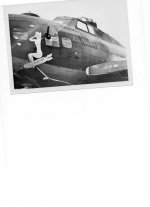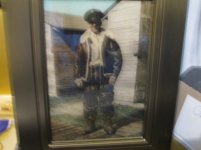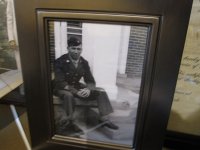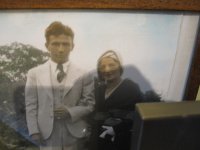Louis Badolato
Lieutenant General
- Joined
- Apr 25, 2005
- Messages
- 17,355
Thanks to the incredibly generous assistance of forum member and retired U.S. Army Major Zach Bogue, as well as his friend Geoff Ward, my family for the first time knows what happened to my Uncle, Tech Sergeant Joseph J. Amanna.
T/Sgt Joseph J. Amanna was assigned to the 96th Bomb Group, 339th Squadron, and, when a staff sergeant, was the right waist gunner on B-17F "Rikki Tikki Tavi" #42-3324, coded QJ-H, flying from Station 138, Snetterton Heath Airbase on Route 11 near Attleborough, England. He was promoted to Tech Sergeant after completing a number of missions, and on the May 7th mission when he was killed, he was the radio operator of the Fortress. The pilot's name was Lt. Neil H. Behrens. The complete crew who flew with my uncle on the fateful day was as follows:
Pilot 2/Lt Neil H. Behrens POW
Co Pilot 2/Lt Gordon N Spring KIA
Navigator 2/Lt Robert A. Dulaney. KIA
Bombardier 2/Lt Thomas J. Mc Rae KIA
Radio T/Sgt Joseph J. Amanna KIA
Eng. T/sgt Carrol W. Taylor POW
Ball Turret S/Sgt Joseph R. Neuhuettler KIA
Waist Gunner S/Sgt Dinno Armanini KIA
Waist Gunner S/Sgt Willis A. Bryant KIA
Tail Gunner S/Sgt Charles E. Douglas KIA
The Missing Air Crew Report #4565, and the accounts of the pilot, Lt. Behrens, and the engineer, T/Sgt Taylor, provide the following account of the mission:
May 7th, 1944 had brought a milestone in combat for the 8th. For the first time the significant figure of 1,000 bombers (B-17s and B-24’s) was dispatched for missions. The main target for this mission was a day attack on Berlin. Despite problems with the valves of the Tokio tank, which had frozen, the Rikki Tikki Tavi had completed its mission and successfully released its bombs over Berlin. On returning from the target, the pilot reduced the altitude in an attempt to defrost the hydraulic fluid, which operates the valves to the Tokio Tanks, which had frozen, up making it impossible for the crew to obtain the fuel in the tokio tanks. The official army accident reports states that three of the engines failed. Basically, the plane ran out of gas just after it left the target, because of the hydraulics failure. Lt. Neil Behrens, the pilot, crawled back to the bomb bay area to try to adjust it. He was unable to open the valve. After getting to lower altitude, the pilot gave orders to bail out. The navigator and Sgt Taylor were the first out. Lt. Neil Behrens, the pilot, jumped separately or by his account was thrown out of the bomb bay doors from the extreme G forces. After their jumps the plane sustained a direct hit by flak, exploded and crashed. Only Lt. Behrens and Sgt Taylor survived.
The fact that the crew chose to remain with the bomber stream and complete their mission, instead of turning from the target in an attempt to get home speaks volumes of my Uncle Joe, and the brave men he flew with. Without the courage and sacrifice of these men and the other members of this greatest generation, none of us would live free. It is my intention, now that I have been provided with a photograph of the Rikki Tikki Tavi, to take Rick Wang of Figarti up on his offer to build me a model of my Uncle's B17, and to take Zach's generous offer to have a friend of his paint me a painting of the Rikki Tikki Tavi to hang over my shrine to my Uncle up in my display area.
I want to extend a special thanks to Zach Bogue ("Zach" here on the forum) and his friend Geoff Ward, without whom I never would have obtained this information.
When I passed it along to my mother, she was in tears. In the course of the research, when I informed her what Zach was doing on our family's behalf, she for the first time told me about how she, a then 11 year old girl, was present in her family kitchen on Washington Avenue in the Bronx when the MIA telegram arrived. Her mother, whom she had never seen smoke, grabbed her younger sister Louise's pack of cigarettes, and began chain smoking. By the time confirmation came of my Uncle's death months later, my grandmother had bleeding ulcers. It really brought home to me the sacrifices made by the families of those brave men as well.
T/Sgt Joseph J. Amanna was assigned to the 96th Bomb Group, 339th Squadron, and, when a staff sergeant, was the right waist gunner on B-17F "Rikki Tikki Tavi" #42-3324, coded QJ-H, flying from Station 138, Snetterton Heath Airbase on Route 11 near Attleborough, England. He was promoted to Tech Sergeant after completing a number of missions, and on the May 7th mission when he was killed, he was the radio operator of the Fortress. The pilot's name was Lt. Neil H. Behrens. The complete crew who flew with my uncle on the fateful day was as follows:
Pilot 2/Lt Neil H. Behrens POW
Co Pilot 2/Lt Gordon N Spring KIA
Navigator 2/Lt Robert A. Dulaney. KIA
Bombardier 2/Lt Thomas J. Mc Rae KIA
Radio T/Sgt Joseph J. Amanna KIA
Eng. T/sgt Carrol W. Taylor POW
Ball Turret S/Sgt Joseph R. Neuhuettler KIA
Waist Gunner S/Sgt Dinno Armanini KIA
Waist Gunner S/Sgt Willis A. Bryant KIA
Tail Gunner S/Sgt Charles E. Douglas KIA
The Missing Air Crew Report #4565, and the accounts of the pilot, Lt. Behrens, and the engineer, T/Sgt Taylor, provide the following account of the mission:
May 7th, 1944 had brought a milestone in combat for the 8th. For the first time the significant figure of 1,000 bombers (B-17s and B-24’s) was dispatched for missions. The main target for this mission was a day attack on Berlin. Despite problems with the valves of the Tokio tank, which had frozen, the Rikki Tikki Tavi had completed its mission and successfully released its bombs over Berlin. On returning from the target, the pilot reduced the altitude in an attempt to defrost the hydraulic fluid, which operates the valves to the Tokio Tanks, which had frozen, up making it impossible for the crew to obtain the fuel in the tokio tanks. The official army accident reports states that three of the engines failed. Basically, the plane ran out of gas just after it left the target, because of the hydraulics failure. Lt. Neil Behrens, the pilot, crawled back to the bomb bay area to try to adjust it. He was unable to open the valve. After getting to lower altitude, the pilot gave orders to bail out. The navigator and Sgt Taylor were the first out. Lt. Neil Behrens, the pilot, jumped separately or by his account was thrown out of the bomb bay doors from the extreme G forces. After their jumps the plane sustained a direct hit by flak, exploded and crashed. Only Lt. Behrens and Sgt Taylor survived.
The fact that the crew chose to remain with the bomber stream and complete their mission, instead of turning from the target in an attempt to get home speaks volumes of my Uncle Joe, and the brave men he flew with. Without the courage and sacrifice of these men and the other members of this greatest generation, none of us would live free. It is my intention, now that I have been provided with a photograph of the Rikki Tikki Tavi, to take Rick Wang of Figarti up on his offer to build me a model of my Uncle's B17, and to take Zach's generous offer to have a friend of his paint me a painting of the Rikki Tikki Tavi to hang over my shrine to my Uncle up in my display area.
I want to extend a special thanks to Zach Bogue ("Zach" here on the forum) and his friend Geoff Ward, without whom I never would have obtained this information.
When I passed it along to my mother, she was in tears. In the course of the research, when I informed her what Zach was doing on our family's behalf, she for the first time told me about how she, a then 11 year old girl, was present in her family kitchen on Washington Avenue in the Bronx when the MIA telegram arrived. Her mother, whom she had never seen smoke, grabbed her younger sister Louise's pack of cigarettes, and began chain smoking. By the time confirmation came of my Uncle's death months later, my grandmother had bleeding ulcers. It really brought home to me the sacrifices made by the families of those brave men as well.






